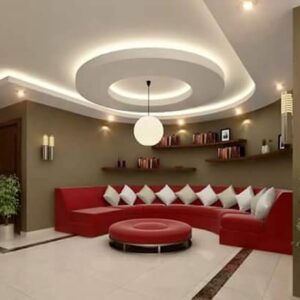Elevate Your Senses: Exploring the Aesthetics of Spa Interior Design
Introduction: In a world buzzing with constant activity, the allure of a spa beckons as a sanctuary for relaxation and rejuvenation. Beyond the soothing treatments, the interior design of a spa plays a pivotal role in creating an atmosphere that transcends the ordinary. In this blog, we delve into the enchanting world of spa interior design, exploring the elements that transform these spaces into havens of tranquility.
- Serene Color Palettes: Spa interiors often feature calming color palettes inspired by nature. Soft hues such as soothing blues, gentle greens, and neutral tones dominate the color scheme. These colors evoke a sense of peace and serenity, setting the tone for a restorative experience.
- Natural Elements and Materials: Integrating natural elements is a hallmark of spa interior design. Wood, stone, bamboo, and other organic materials are commonly used to create a harmonious connection with the natural world. Live plants, water features, and natural textures contribute to the overall ambiance, fostering a sense of balance.
- Thoughtful Lighting Design: Lighting is a key element in spa interiors, with a focus on creating a tranquil and warm atmosphere. Soft, diffused lighting enhances the relaxation experience. Consideration is given to both natural and artificial lighting, with features like dimmers and candles to adjust the ambiance accordingly.
- Comfortable and Luxurious Furnishings: The furnishings in a spa are chosen for both comfort and luxury. Plush seating, cozy loungers, and soft textiles contribute to the overall relaxation experience. High-quality materials and ergonomic designs ensure that clients feel pampered from the moment they enter the space.
- Harmonious Flow and Layout: The layout of a spa is designed to promote a harmonious flow. Spaces are organized to create a journey, from reception areas to treatment rooms, with careful attention to transitions. Open layouts and unobtrusive design elements contribute to a seamless and calming environment.
- Tranquil Soundscapes: Spa interiors often incorporate soothing sounds to enhance relaxation. Gentle music, water features, and nature-inspired sounds create a tranquil atmosphere, drowning out the noise of the outside world and immersing clients in a peaceful cocoon.
- Wellness-focused Art and Décor: Artwork and décor in spa interiors often align with wellness themes. Inspirational quotes, serene landscapes, and abstract art that evokes a sense of calm may adorn the walls. These elements contribute to the overall sense of tranquility and well-being.
- Customization for Different Spaces: Spa interior designs recognize the diverse needs of different spaces within the facility. Whether it’s the communal relaxation area, treatment rooms, or saunas, each space is tailored to create a unique and immersive experience for clients.
- Technology Integration for Comfort: While maintaining a focus on tranquility, modern spas also integrate technology for enhanced comfort. This may include features like heated treatment tables, climate control, and state-of-the-art equipment, ensuring that clients experience both luxury and innovation.
- Sustainable Practices: Many contemporary spa designs embrace sustainability. From eco-friendly building materials to energy-efficient lighting, spas are increasingly incorporating green practices to align with a holistic approach to well-being.
Conclusion: In the enchanting realm of spa interior design, every element is carefully curated to create an oasis of tranquility. The interplay of colors, materials, lighting, and sound converges to elevate the senses, offering a respite from the hectic pace of everyday life. Ultimately, spa interiors are not just spaces; they are immersive experiences designed to nurture the mind, body, and spirit.
Frequently Asked Questions: Spa Interior Designs
- Q: Why is spa interior design important?A: Spa interior design plays a crucial role in creating a serene and rejuvenating atmosphere. It enhances the overall spa experience, contributing to relaxation and well-being.
- Q: What colors are commonly used in spa interior designs?A: Spa interiors often feature calming colors such as soft blues, gentle greens, and neutral tones. These hues evoke a sense of peace and tranquility.
- Q: How do natural elements contribute to spa interiors?A: Natural elements like wood, stone, bamboo, and live plants are used to create a connection with nature. They contribute to a harmonious and balanced environment within the spa.
- Q: What role does lighting play in spa interiors?A: Lighting in spa interiors is carefully designed to create a tranquil atmosphere. Soft, diffused lighting enhances relaxation, and features like dimmers and candles allow for adjustable ambiance.
- Q: Why are comfortable furnishings important in spa interiors?A: Comfortable and luxurious furnishings contribute to the overall relaxation experience. Plush seating, cozy loungers, and soft textiles ensure clients feel pampered and comfortable.
- Q: How is the layout of a spa designed to enhance the experience?A: Spa layouts are organized to create a harmonious flow, guiding clients through different spaces seamlessly. Open layouts and thoughtful transitions contribute to a calming environment.
- Q: What sounds are commonly integrated into spa interiors?A: Spa interiors often incorporate soothing sounds like gentle music, water features, and nature-inspired sounds. These elements enhance relaxation and drown out external noise.
- Q: How is wellness-focused art and décor incorporated into spa interiors?A: Artwork and décor in spa interiors often align with wellness themes. Inspirational quotes, serene landscapes, and abstract art contribute to the overall sense of tranquility.
- Q: Is technology integrated into spa interiors?A: Yes, modern spas may integrate technology for enhanced comfort. This can include features like heated treatment tables, climate control, and state-of-the-art equipment.
- Q: Are sustainable practices considered in spa interior designs?A: Yes, many contemporary spa designs embrace sustainability. This includes the use of eco-friendly building materials, energy-efficient lighting, and other green practices to align with holistic well-being.


